Field Test of Wind Power Output Fluctuation Control Using an Energy Storage System on Jeju Island
Abstract
1. Introduction
- Performance of stabilizing the output of the wind turbine using ESS;
- Operation of the ESS when the wind turbine suddenly stopped due to an accident;
- Reaching the target SOC while performing wind power output stabilization control and discharging the energy stored in the battery, at the time of peak load in the Jeju Island power system;
- Simulation analysis of the failure to control the stabilization of wind power output.
2. Control Theory
3. Configuration of Pilot Project
4. Results of Pilot Project
4.1. Operation of Ramp-Rate Control in Normal State
4.2. Operation of Ramp-Rate Control When the Wind Turbine Suddenly Stops
4.3. Discharging the Energy in Daily Peak Demand Time
4.4. Simulation and Discussion
5. Conclusion
Author Contributions
Funding
Acknowledgments
Conflicts of Interest
Abbreviations
| HVDC | High voltage direct current transmission system |
| ESS | Energy storage system |
| RPS | Renewable energy portfolio standard |
| SOC | State-of-charge |
| PCS | Power conversion system |
| BMS | Battery management system |
| EMS | Energy management system |
| DOD | Depth-of-discharge |
| AC | Alternative current |
| DC | Direct current |
| Limited wind power variation per sampling time (kW) | |
| Limited fluctuation rate per minute (%) | |
| Wind turbine or farm capacity (kW) | |
| Sampling time (s) | |
| Total output target value (kW) | |
| Difference between the wind power output and the previous total output target value (kW) | |
| Wind power output (kW) | |
| Weight factor | |
| Discrete time signal (1, 2, 3 …) | |
| Set value (< 1) | |
| SOC target value (per unit) | |
| Output of the ESS (kW) | |
| PCS capacity of the ESS (kW) | |
| Lower limit value of SOC (per unit) | |
| Upper limit value of SOC (per unit) | |
| Total output of wind power and ESS (kW) | |
| Capacity of the battery (kWh) | |
| Fluctuation rate per minute of the total output (%) | |
| max() | Maximum value operator |
| min() | Minimum value operator |
References
- Li, X.; Song, Y.-J.; Han, S.-B. Study on Power Quality Control in Multiple Renewable Energy Hybrid MicroGrid System. In Proceedings of the 2007 IEEE Lausanne Power Tech, Lausanne, Switzerland, 1–5 July 2007. [Google Scholar]
- Lin, J.; Sun, Y.Z.; Sørensen, P.; Li, G.J.; Li, X. Frequency Modeling of Wind Power Fluctuation and the Application on Power Systems. In Proceedings of the International Conference on Power System Technology, Hangzhou, China, 24–28 October 2010; pp. 1–8. [Google Scholar]
- Guo, P.; Chen, S.; Chu, J.; Infield, D. Wind direction fluctuation analysis for wind turbines. Renew. Energy 2020, 162, 1026–1035. [Google Scholar] [CrossRef]
- Zhang, E.; Huang, W.; Tai, N.; Chen, Z.; Ruan, W. A coordination strategy to smooth fluctuation of distributed renewable energy in combined heat and power community microgrids. In Proceedings of the 8th Renewable Power Generation Conference (RPG 2019), Shanghai, China, 24–25 October 2019. [Google Scholar]
- Jeju Special Self-Governing Province Local Government. Carbon Free Island Jeju by 2030; Jeju Special Self-Governing Province Local Government: Jeju Special Self-Governing Province, Korea, 2012. Available online: http://www.investkorea.org/jeju_en/about/cfi2030.do (accessed on 20 August 2020).
- Muljadi, E.; Butterfield, C.P.; Chacon, J.; Romanowitz, H. Power quality aspects in a wind power plant. In Proceedings of the 2006 IEEE Power Engineering Society General Meeting, Montreal, QC, Canada, 18–22 June 2006. [Google Scholar]
- Kim, J.H.; Van-Hoan, P.; Kim, E.H.; Kim, S.H.; Oh, S.B.; Young-Hwan, K.; Jang, G.S. Analysis of power quality on wind power fluctuation during HVDC overhaul period in Jeju island power system. In Proceedings of the 2009 IEEE 6th International Power Electronics and Motion Control Conference, Wuhan, China, 17–20 May 2009. [Google Scholar]
- Chang, M.; Bae, S.; Yoon, G.; Park, S.; Choy, Y. Impact of Electric Vehicle Charging Demand on a Jeju Island Radial Distribution Network. In Proceedings of the 2019 IEEE Power & Energy Society Innovative Smart Grid Technologies Conference (ISGT), Washington, DC, USA, 18–21 February 2019. [Google Scholar]
- Honrubia-Escribano, A.; Gómez-Lázaro, E.; Fortmann, J.; Sørensen, P.; Martin-Martinez, S. Generic dynamic wind turbine models for power system stability analysis: A comprehensive review. Renew. Sustain. Energy Rev. 2018, 81, 1939–1952. [Google Scholar] [CrossRef]
- Chang, Y.; Fu, K. Smoothing Control of Doubly-Fed Induction Generator Wind Turbine under Different Wind Conditions. In Proceedings of the 2015 Asia-Pacific Energy Equipment Engineering Research Conference, Zhuhai, China, 13–14 June 2015. [Google Scholar]
- Gholami, M.; Shahryari, O.-K. A new control strategy for PMSG based wind turbine to improve power smoothing. Kurd. J. Appl. Res. 2017, 2, 356–360. [Google Scholar] [CrossRef][Green Version]
- Shivashankar, S.; Mekhilef, S.; Mokhlis, H.; Karimi, M. Mitigating methods of power fluctuation of photovoltaic (PV) sources—A review. Renew. Sustain. Energy Rev. 2016, 59, 1170–1184. [Google Scholar] [CrossRef]
- Lee, D.; Baldick, R. Limiting Ramp Rate of Wind Power Output using a Battery Based on the Variance Gamma Process. In Proceedings of the 2012 International Conference on Renewable Energies and Power Quality, Santiago de Compostela, Spain, 28–30 March 2012. [Google Scholar]
- Yan, R.; Saha, T.K. Power ramp rate control for grid connected photovoltaic system. In Proceedings of the 2010 Conference Proceedings IPEC, Singapore, 27–29 October 2010. [Google Scholar]
- De Rijcke, S.; Driesen, J.; Meyers, J. Power smoothing in large wind farms using optimal control of rotating kinetic energy reserves. Wind Energy 2014, 18, 1777–1791. [Google Scholar] [CrossRef]
- Pratap, A.; Urasaki, N.; Senju, T. Control Strategies for Smoothing of Output Power of Wind Energy Conversion Systems. Int. J. Emerg. Electr. Power Syst. 2018, 14, 525–534. [Google Scholar] [CrossRef]
- Xu, G.; Xu, L.; Yao, L. Wind turbines output power smoothing using embedded energy storage systems. J. Mod. Power Syst. Clean Energy 2013, 1, 49–57. [Google Scholar] [CrossRef]
- Lee, D.; Kim, J.; Baldick, R. Stochastic Optimal Control of the Storage System to Limit Ramp Rates of Wind Power Output. Ieee Trans. Smart Grid 2013, 4, 2256–2265. [Google Scholar] [CrossRef]
- Esmaili, A.; Nasiri, A. Power smoothing and power ramp control for wind energy using energy storage. In Proceedings of the 2011 IEEE Energy Conversion Congress and Exposition, Phoenix, AZ, USA, 17–22 September 2011. [Google Scholar]
- Li, X. Fuzzy Adaptive Kalman Filter for Wind Power Output Smoothing with Battery Energy Storage System. Iet Renew. Power Gener. 2012, 6, 340–347. [Google Scholar] [CrossRef]
- Koshimizu, G.; Numata, T.; Yoshimoto, K.; Hasuike, H.; Shibata, T. Subaru Project: Application of Energy Storage for Stabilization of Wind Power in Power Systems. In Proceedings of the ESA 2005 Annual Meeting Conference Energy Storage Association, Toronto, ON, Canada, May 2005. [Google Scholar]
- Koshimizu, G.; Numata, T.; Yoshimoto, K.; Hasuike, H.; Shibata, T. Subaru Project: Analysis of Field test results for Stabilization of 30.6MW Wind Farm with Energy storage. In Proceedings of the Electrical Energy Storage Applications and Technologies 2007 Conf. Energy Storage Association, San Francisco, CA, USA, 24–26 September 2007. [Google Scholar]
- Yoshimoto, K.; Nanahara, T.; Koshimizu, G.; Uchida, T. New Control Method for Regulating State of Charge of a Battery in Hybrid Wind Power/Battery Energy Storage System. In Proceedings of the 2006 IEEE PES Power Systems Conference & Exposition, Atlanta, GA, USA, 29 October–1 November 2006; pp. 1244–1251. [Google Scholar]
- POSCO ICT. New Renewable Generator Output Control Device and Method. Korean Patent 10-1514886, 11 March 2015. [Google Scholar]
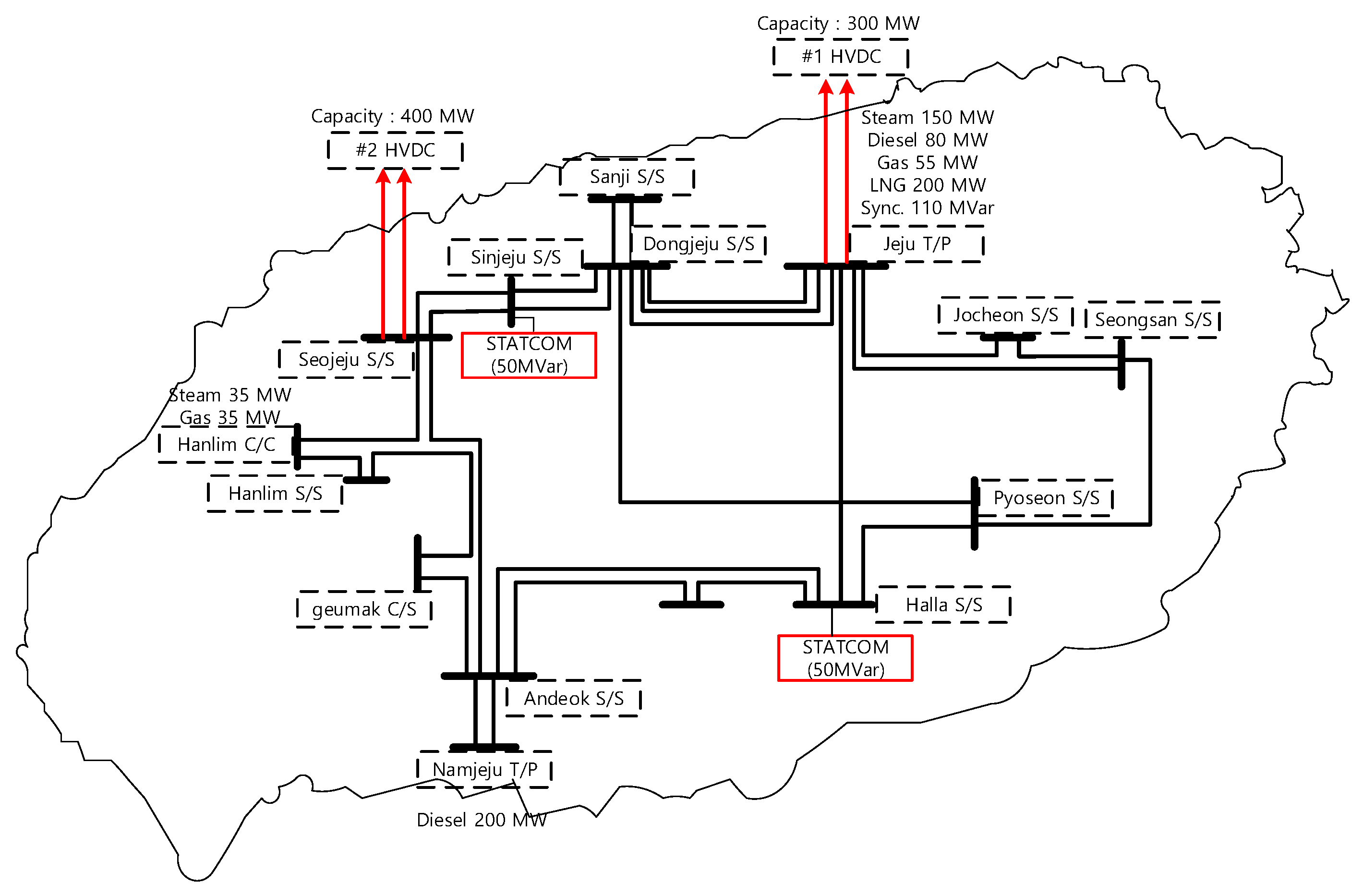
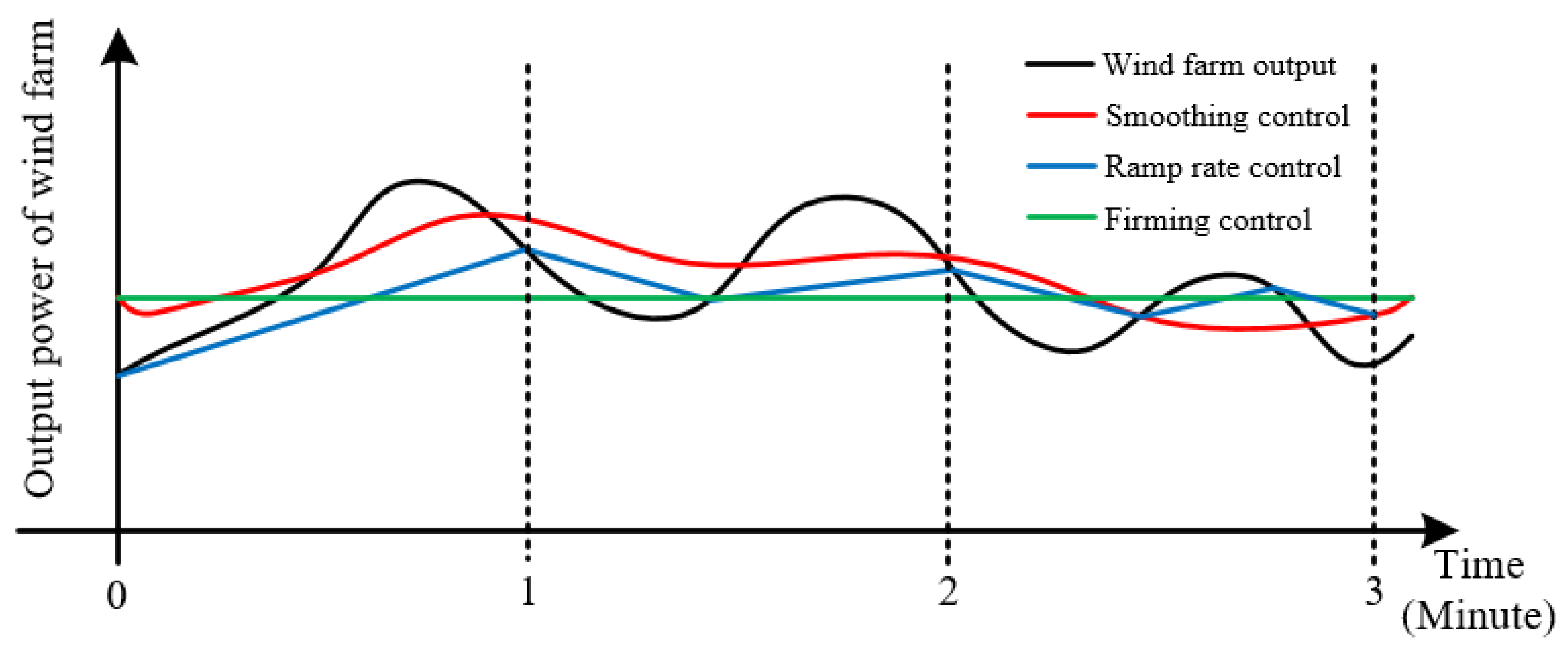
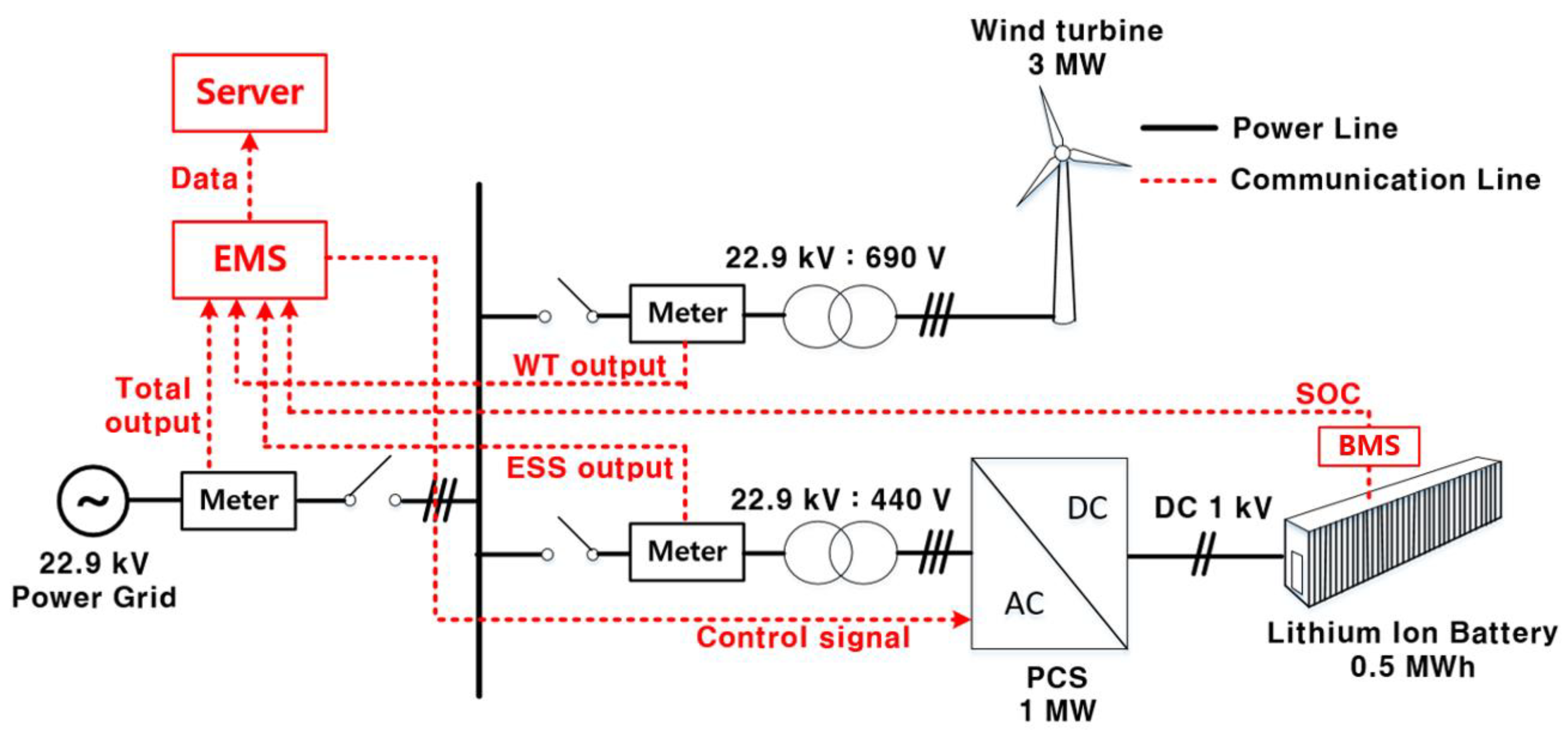
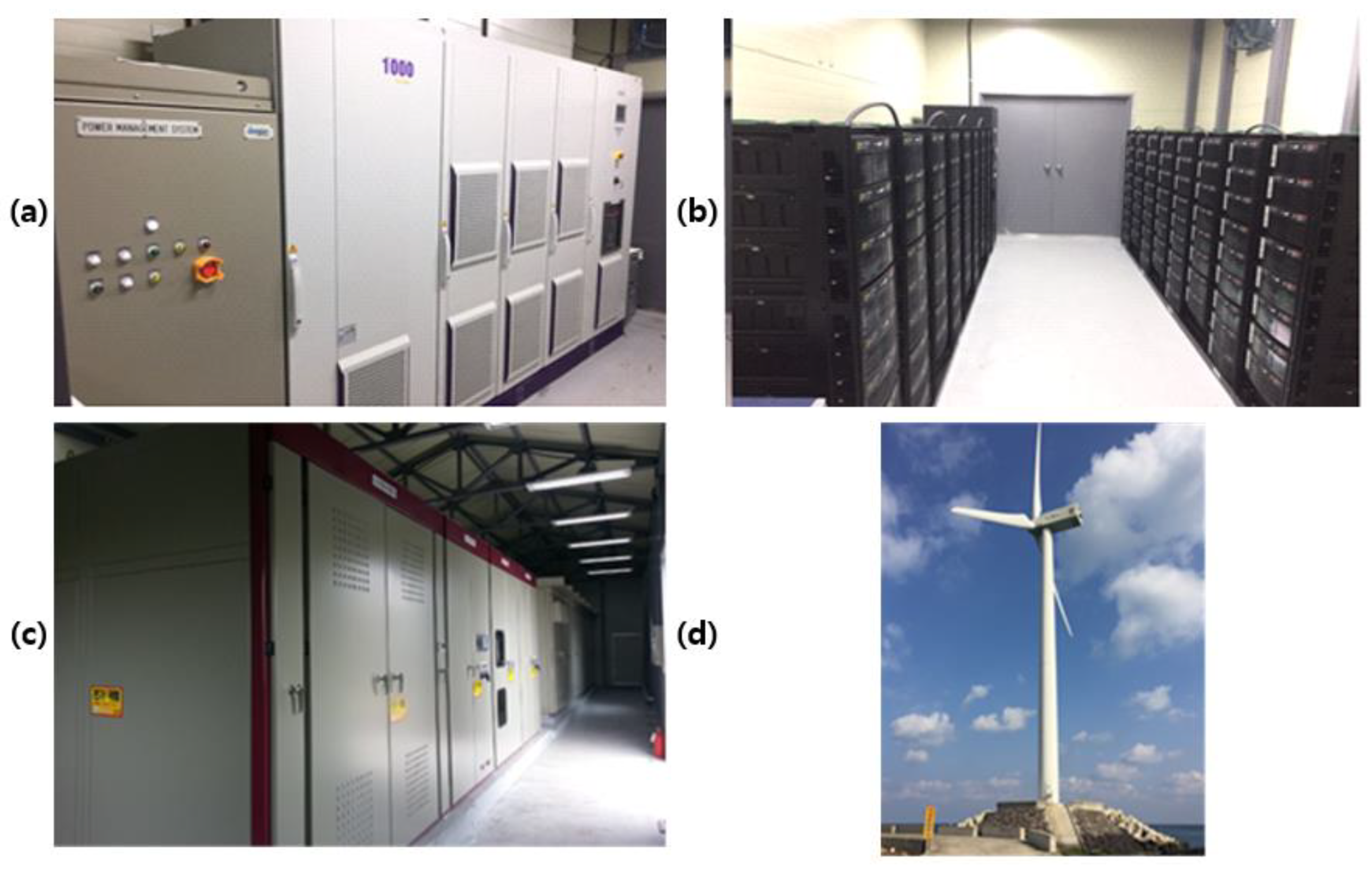
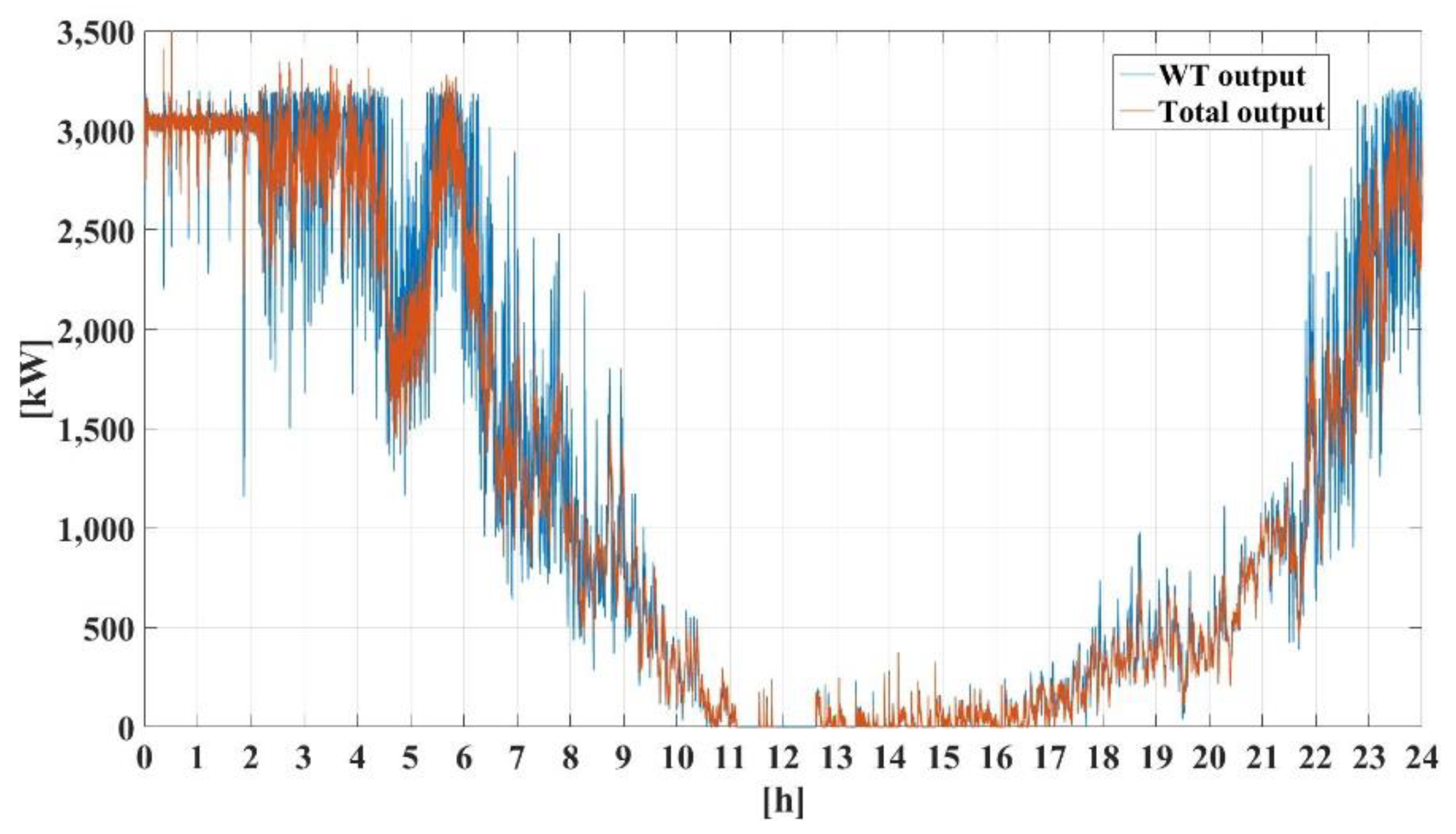
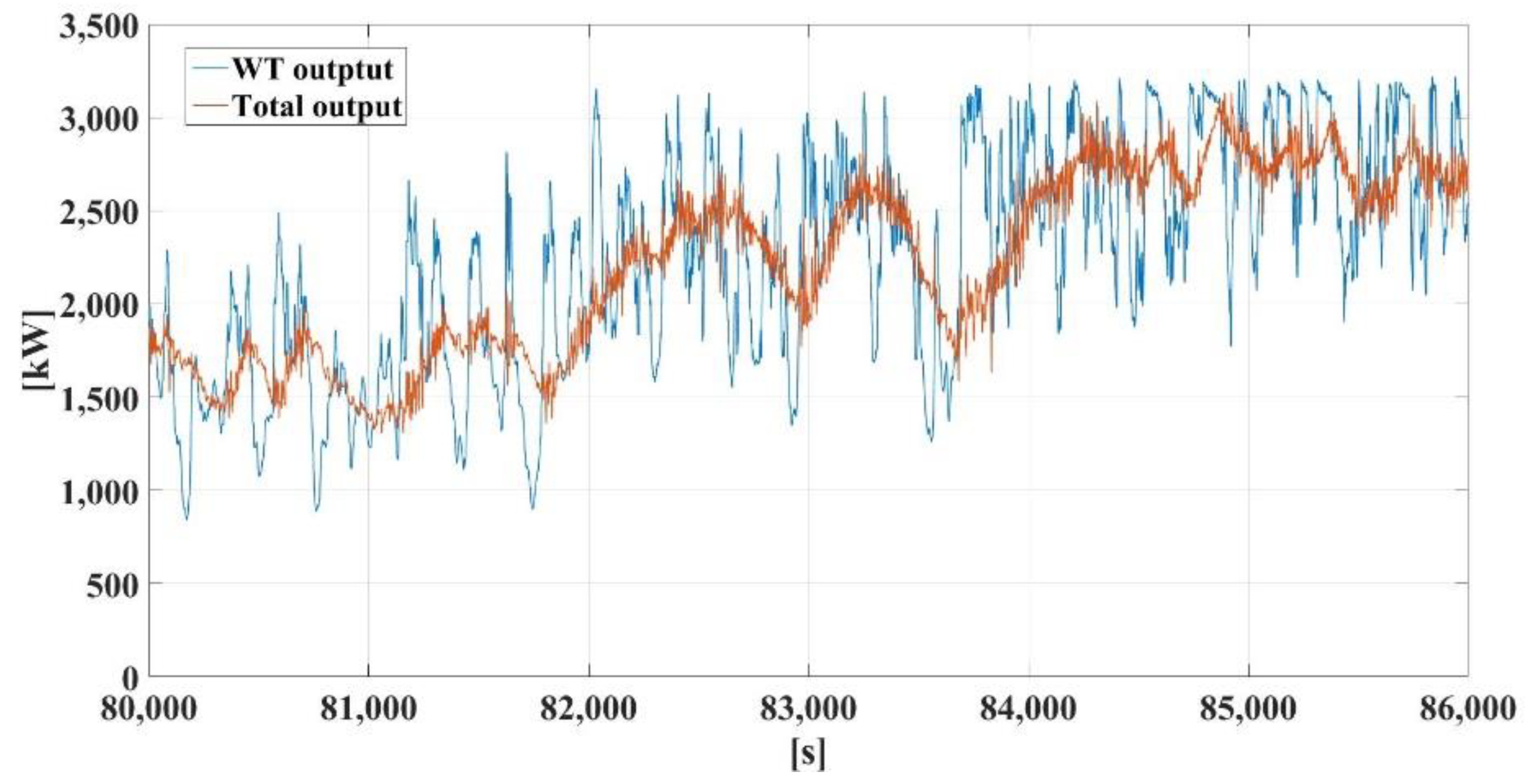
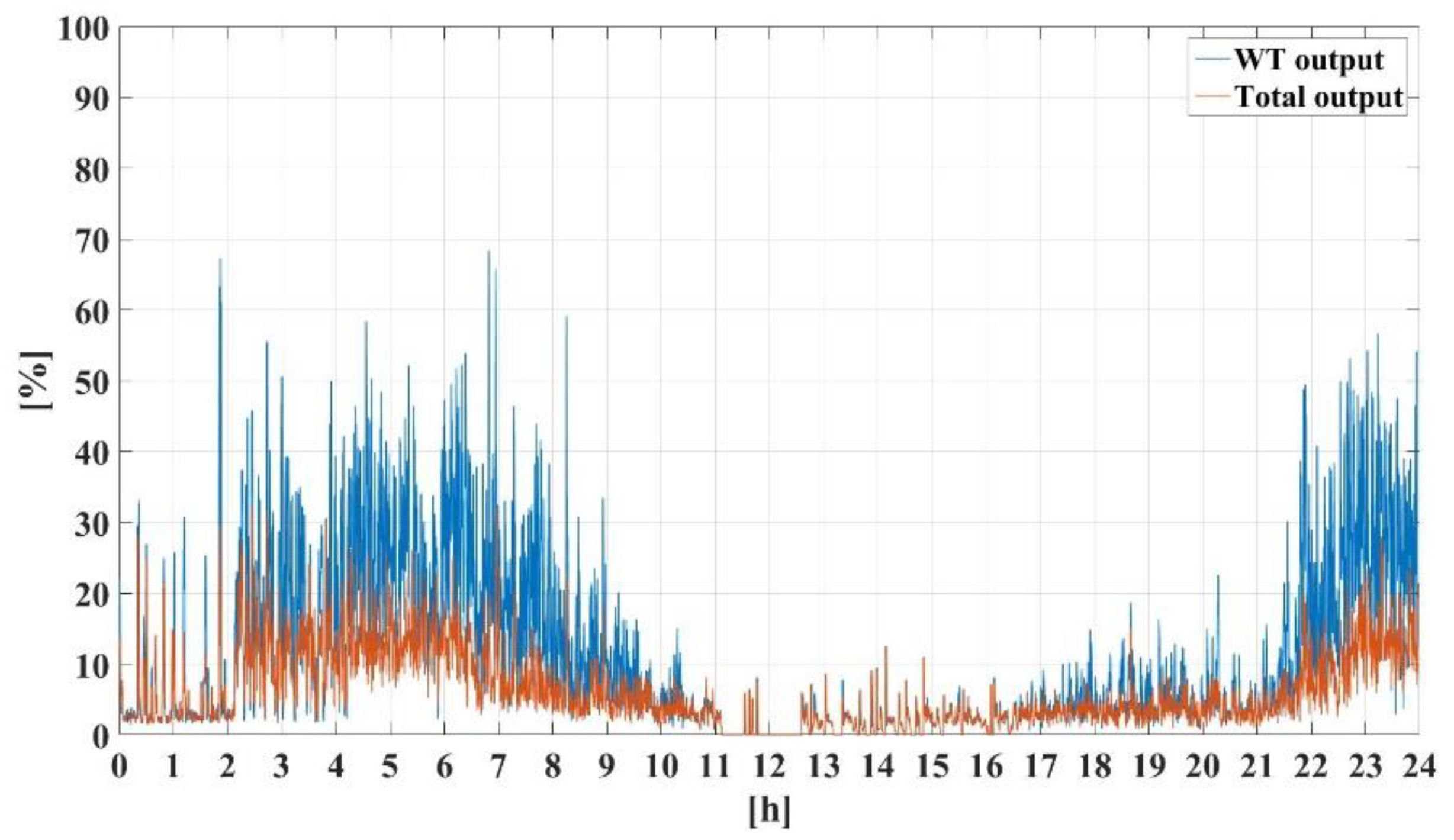
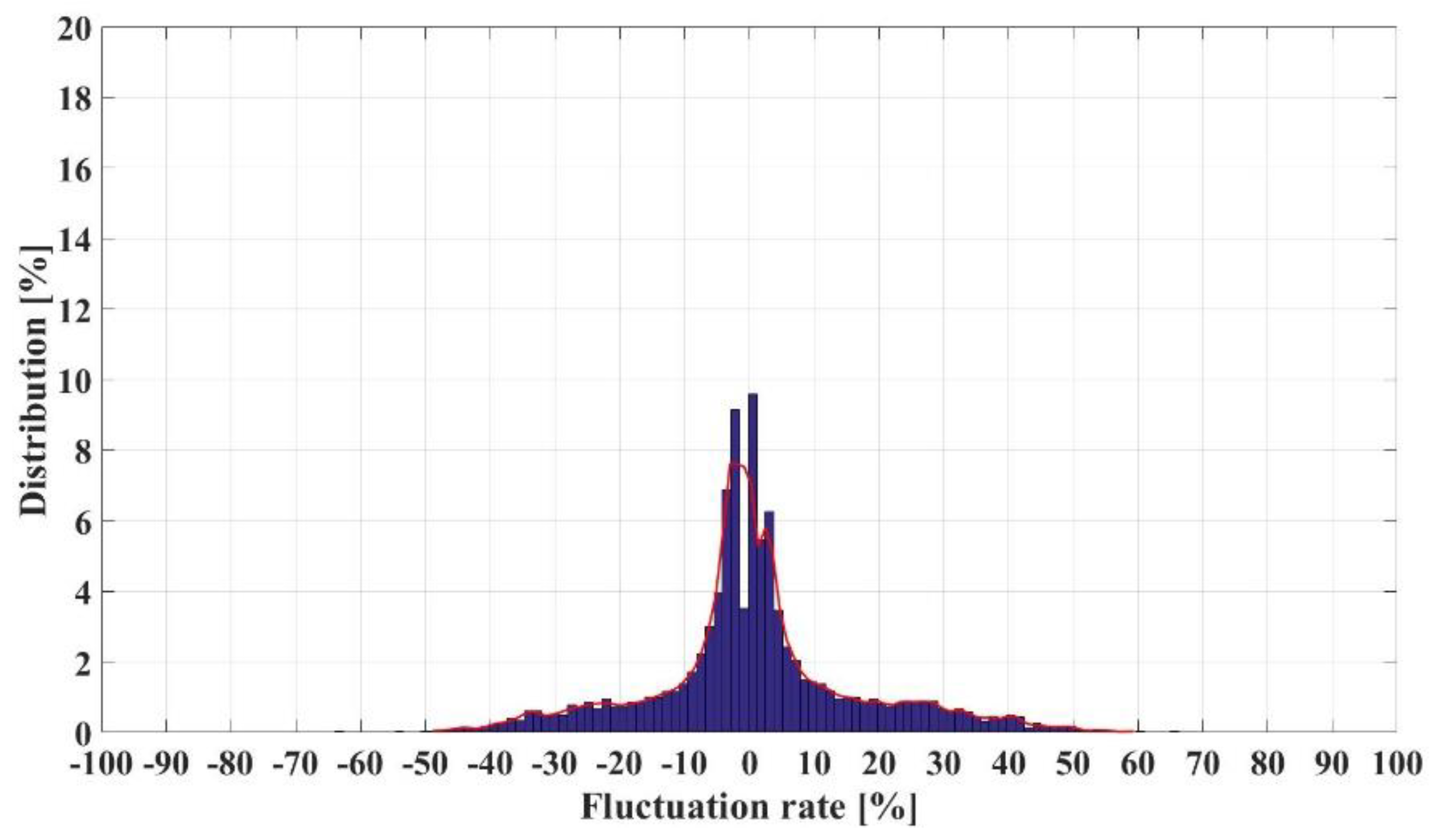
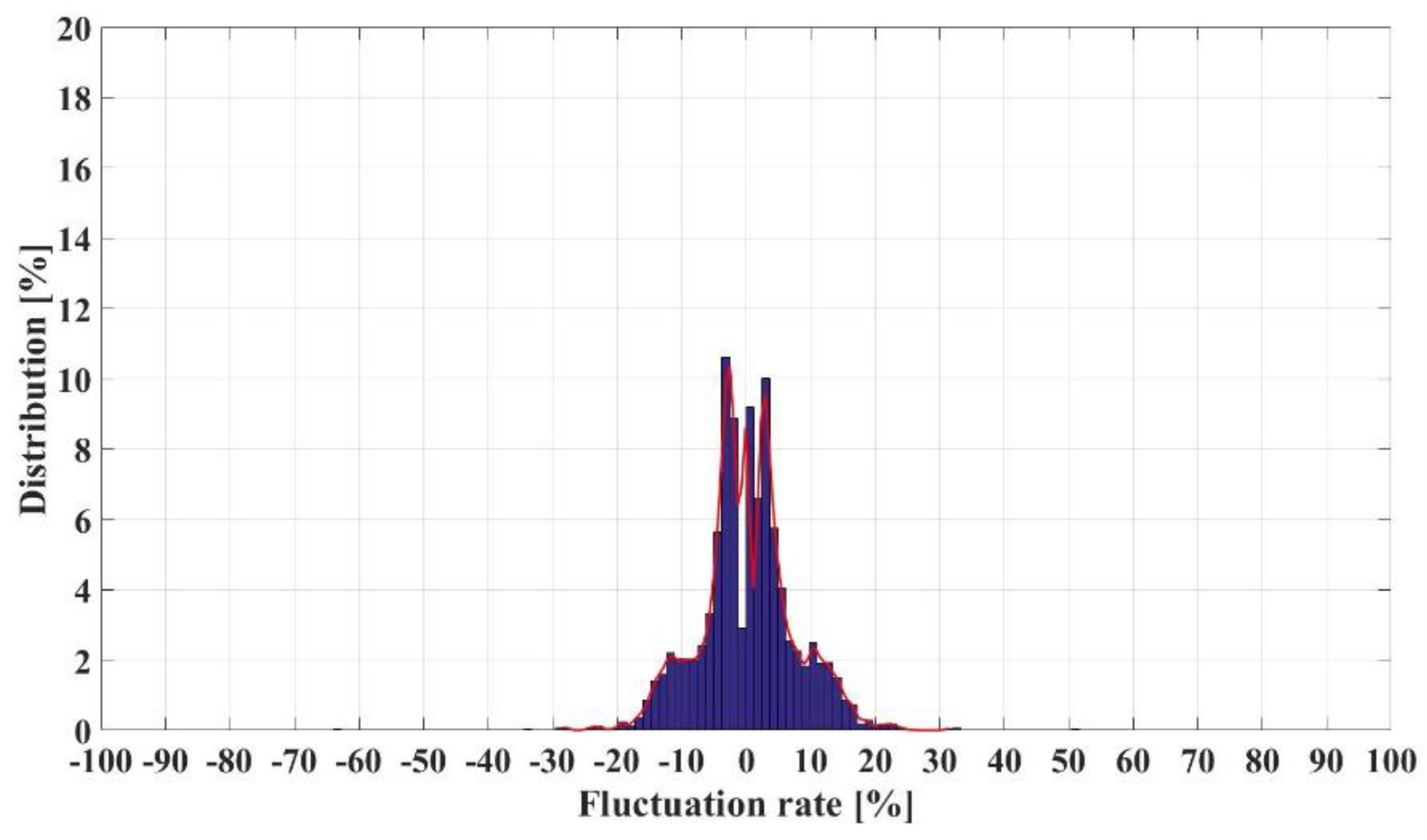
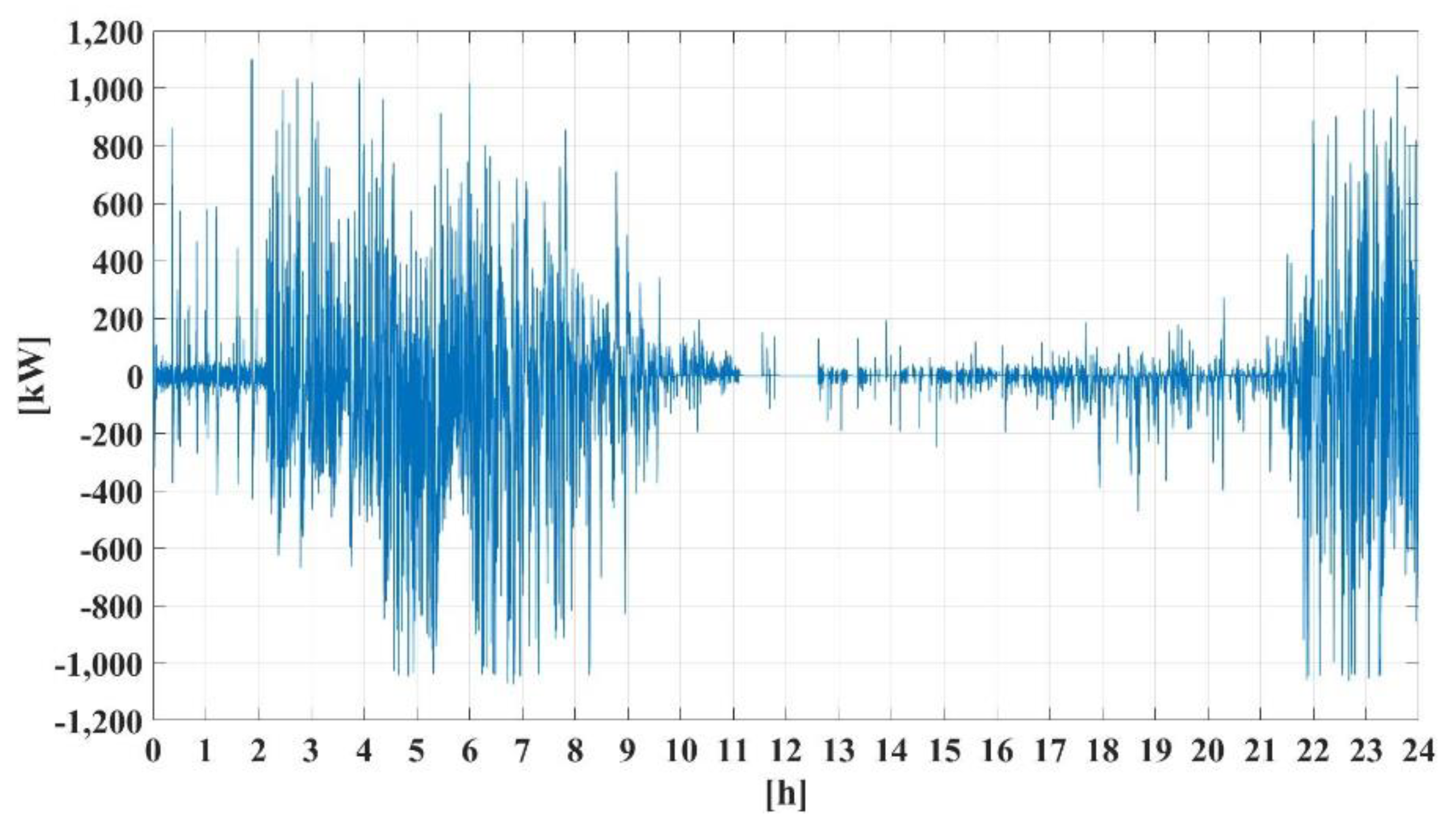

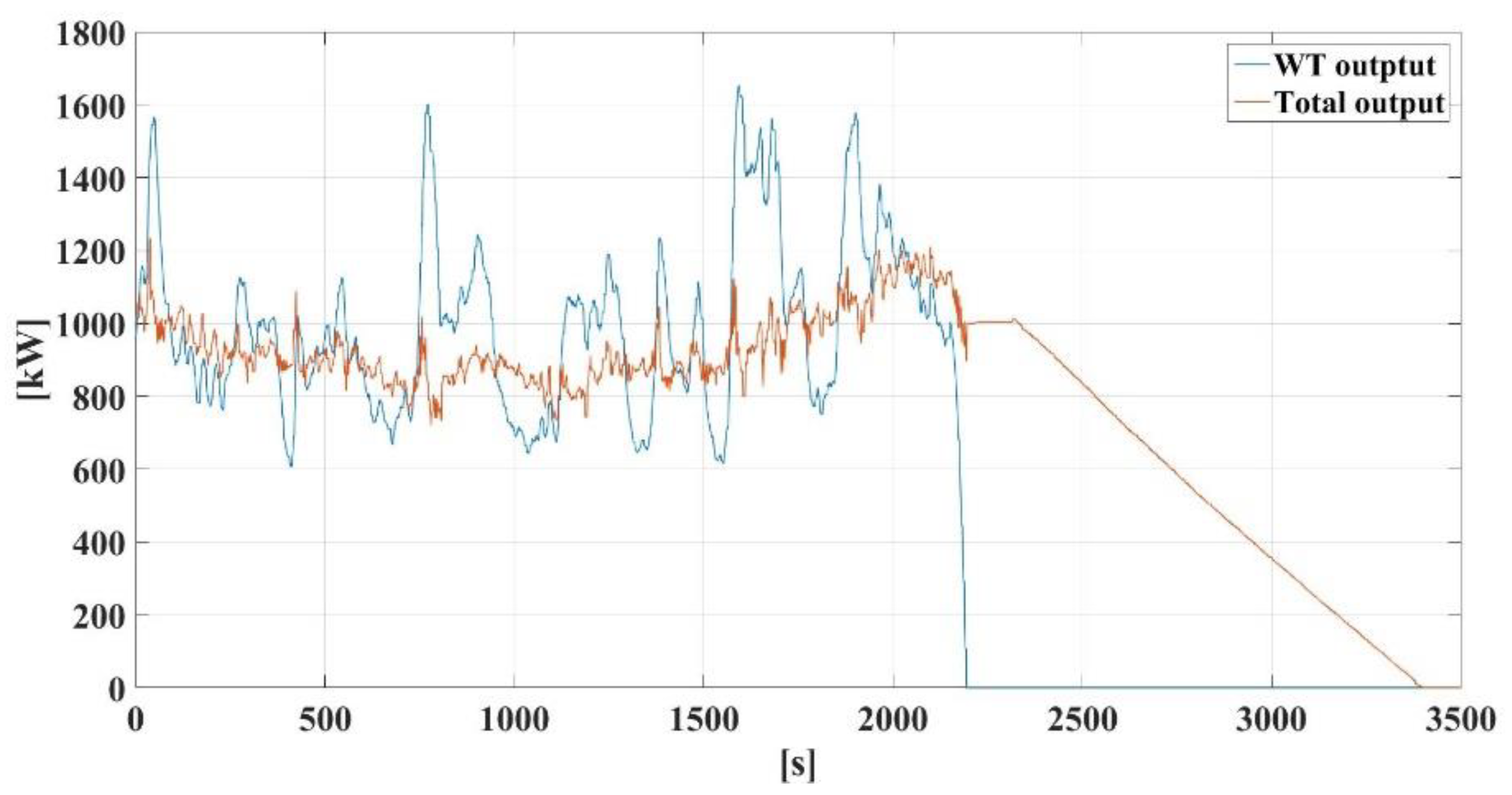
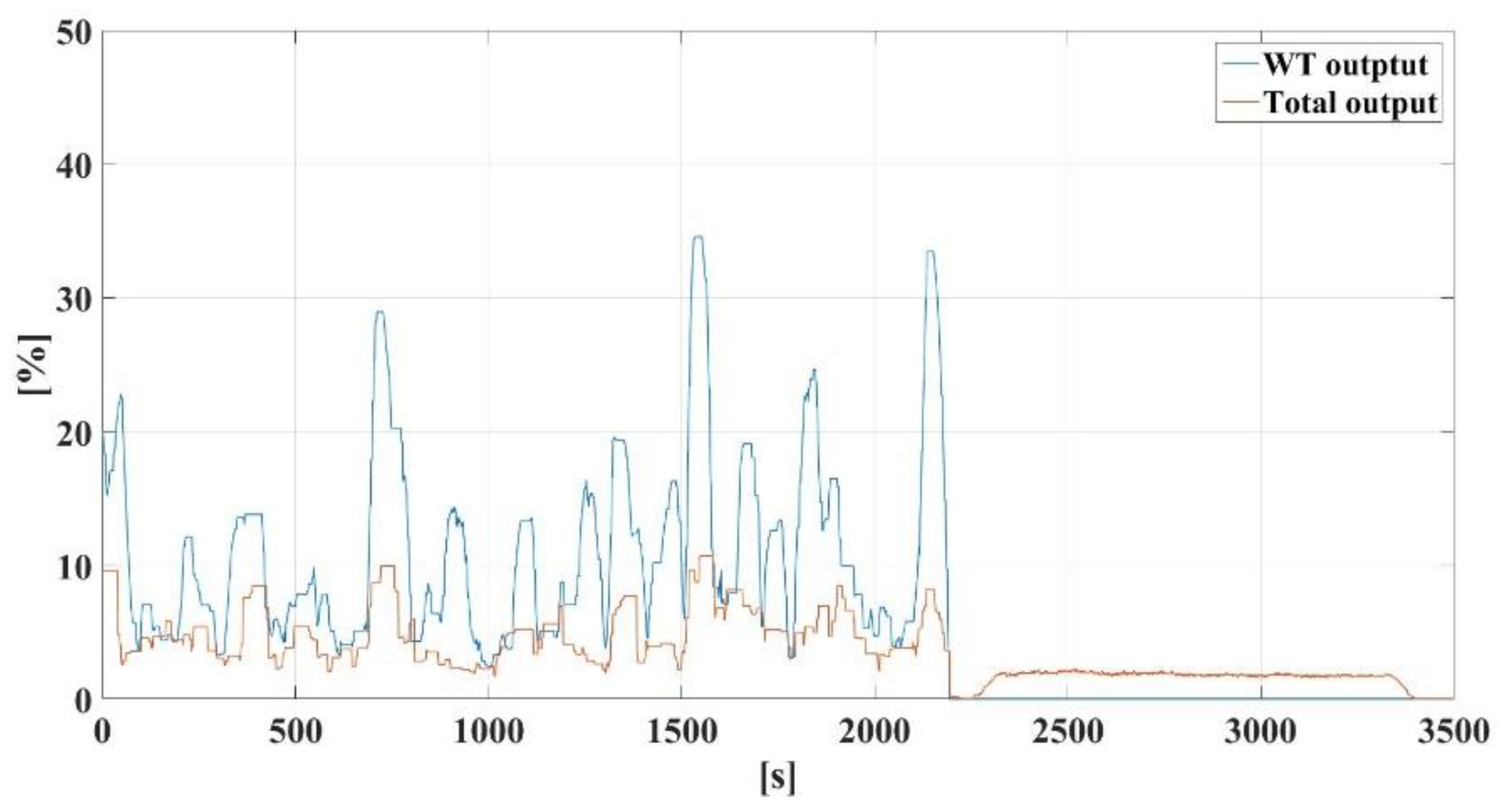

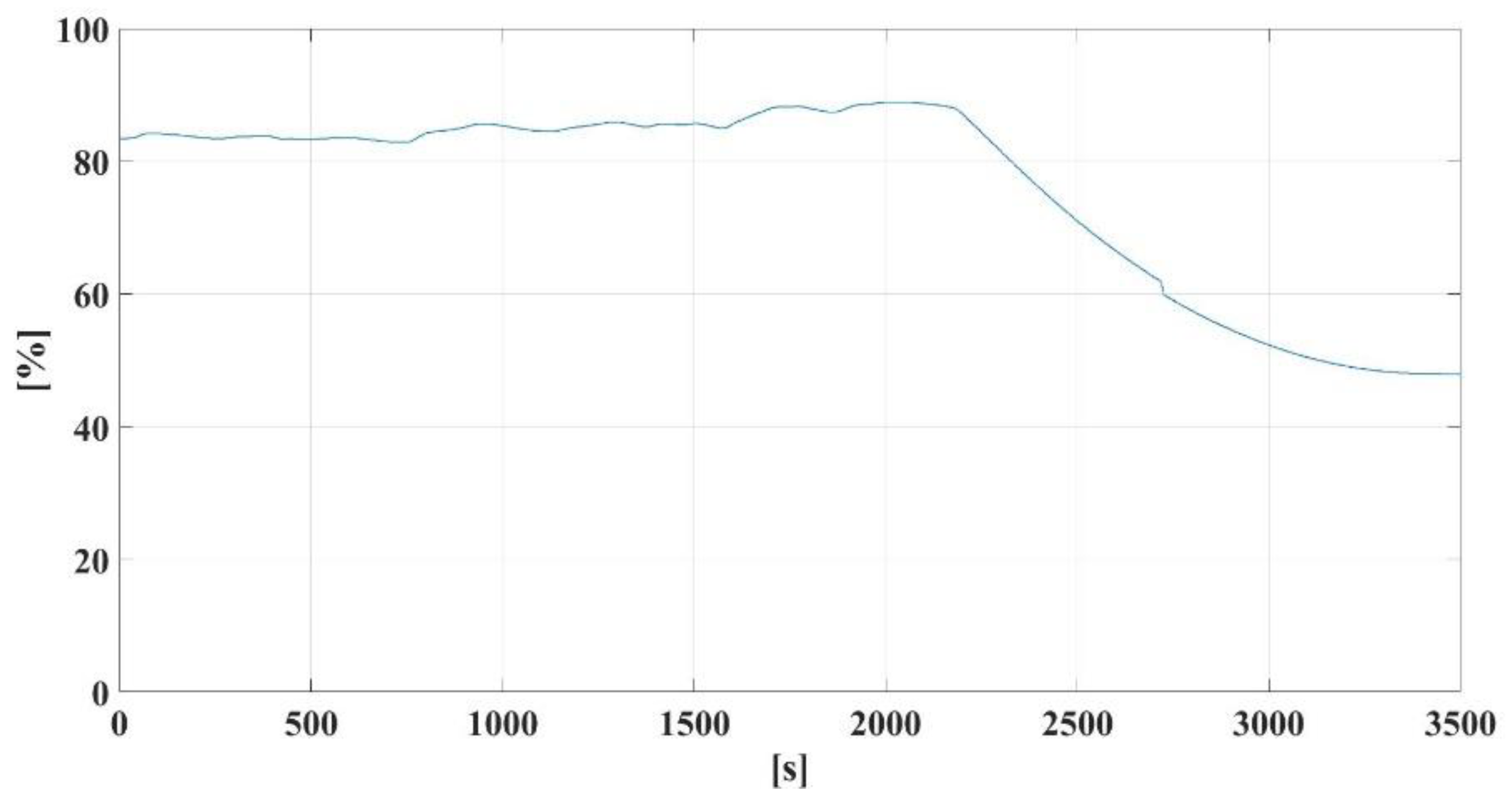
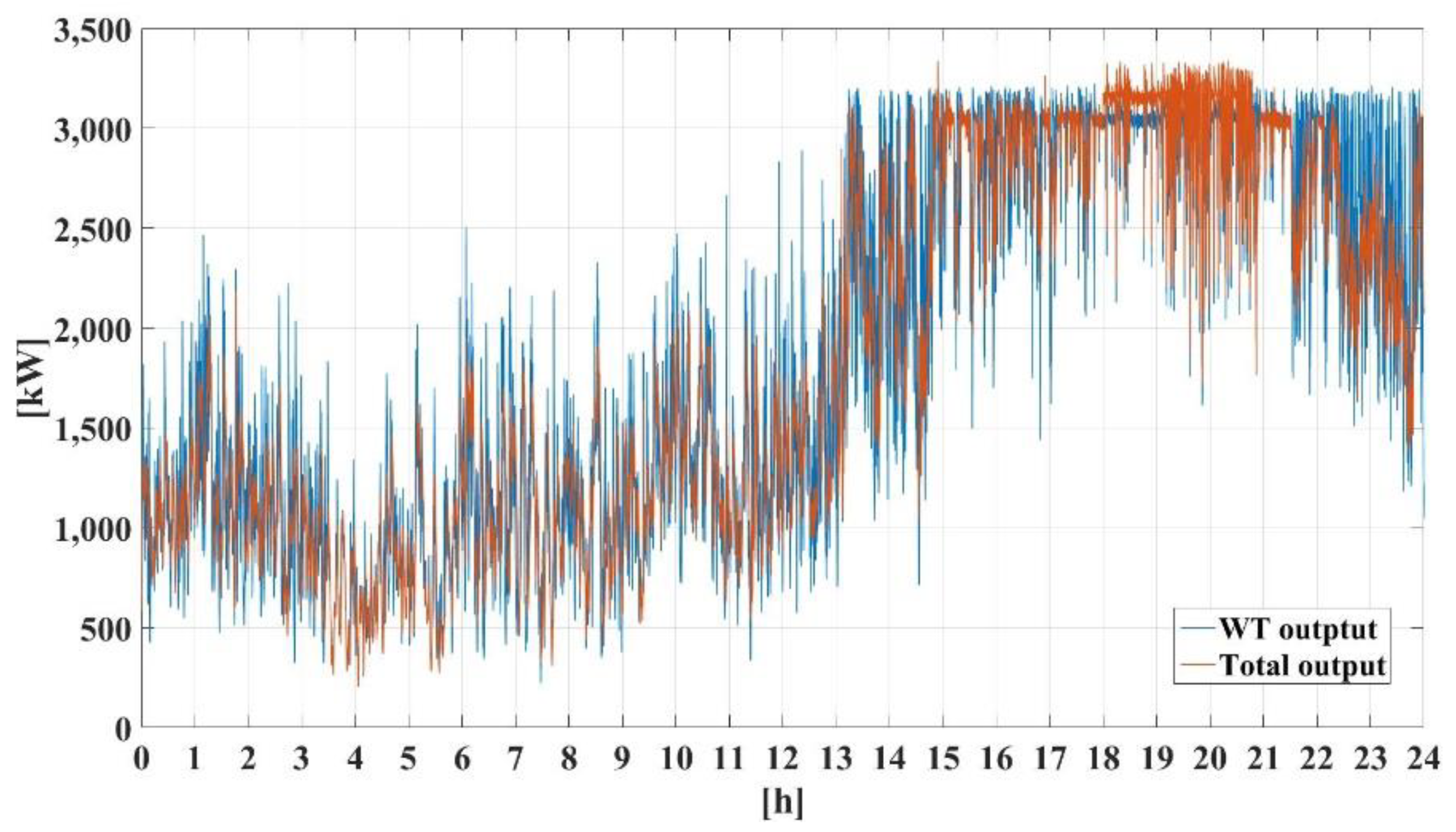
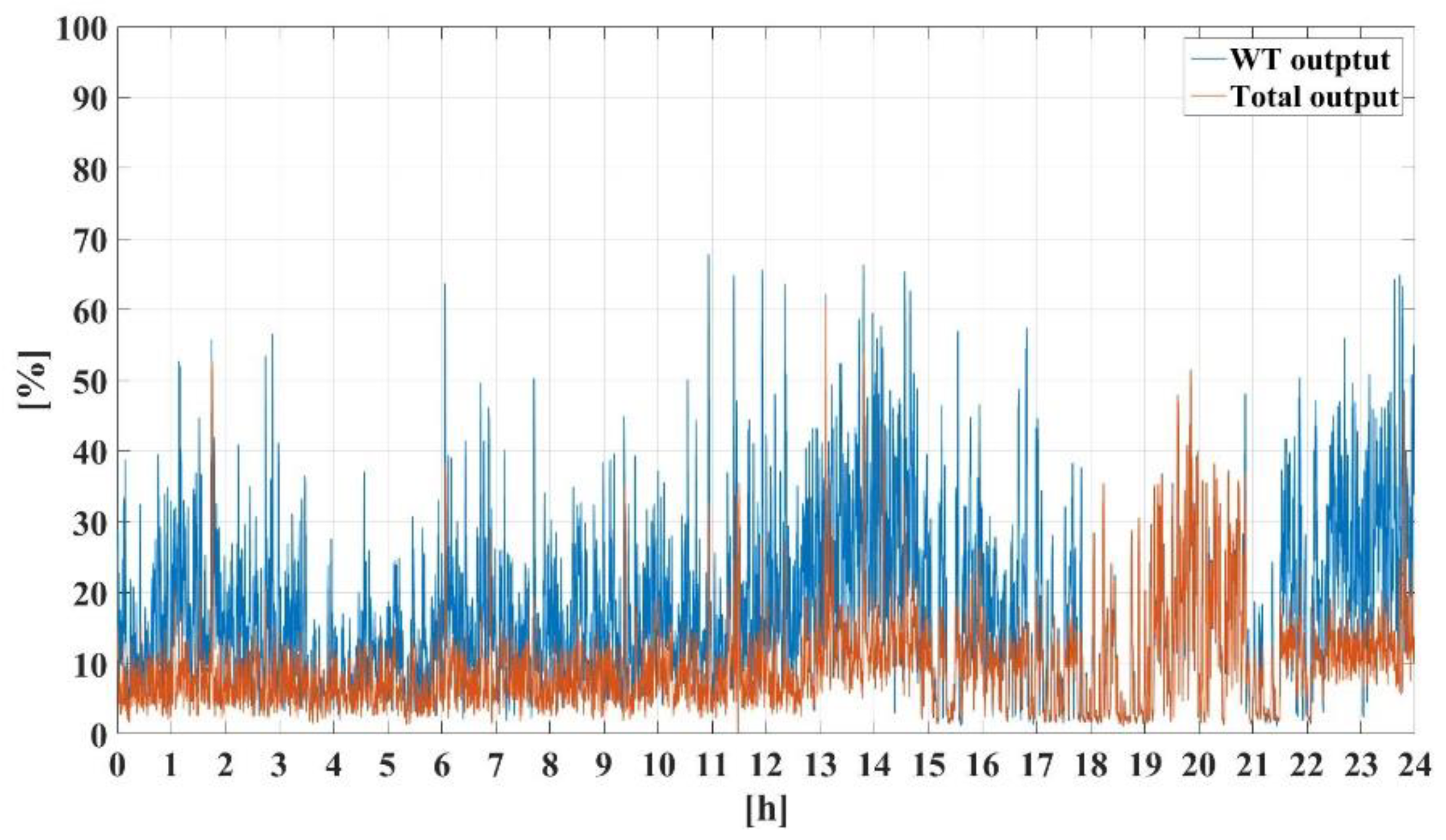
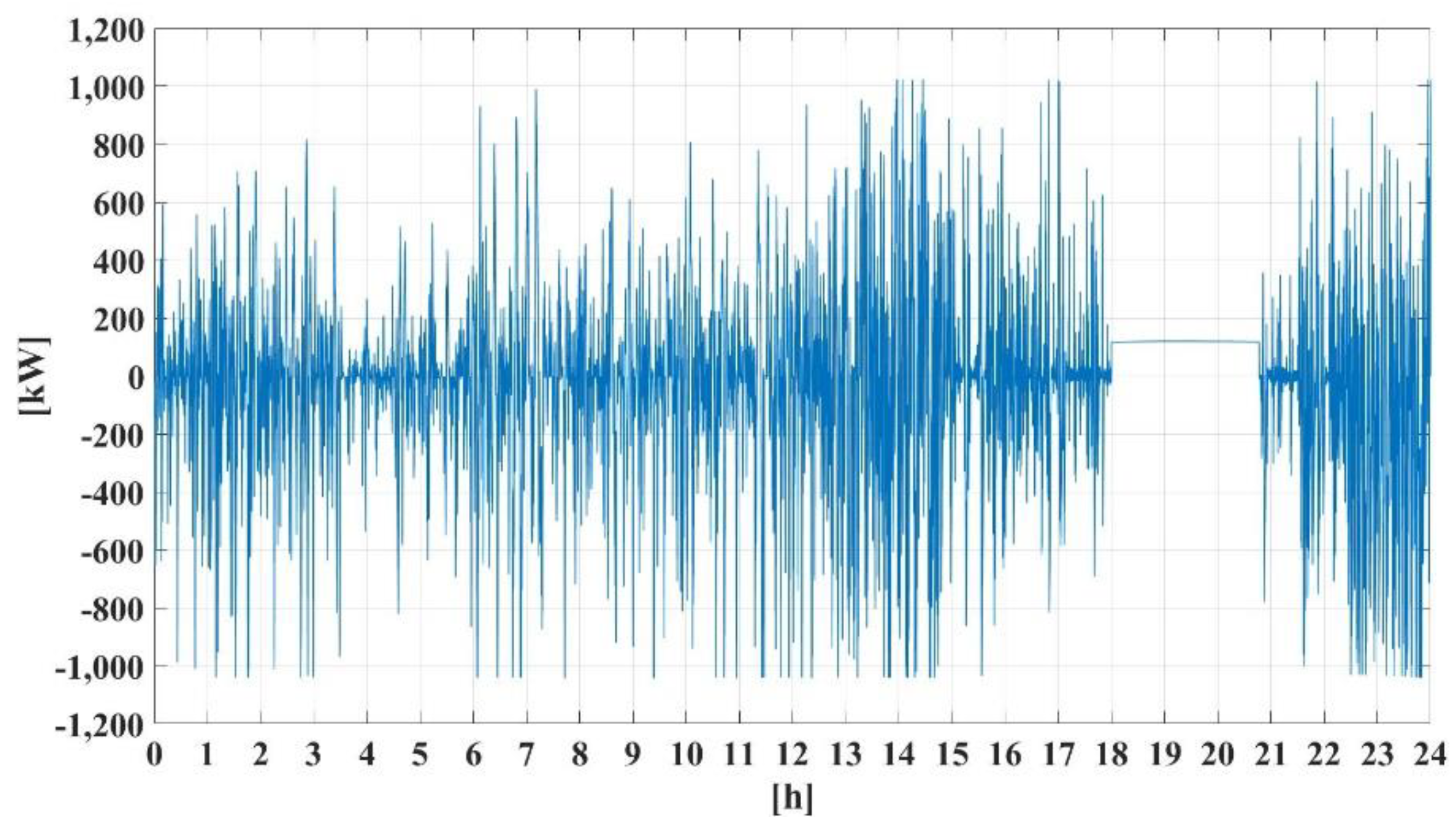
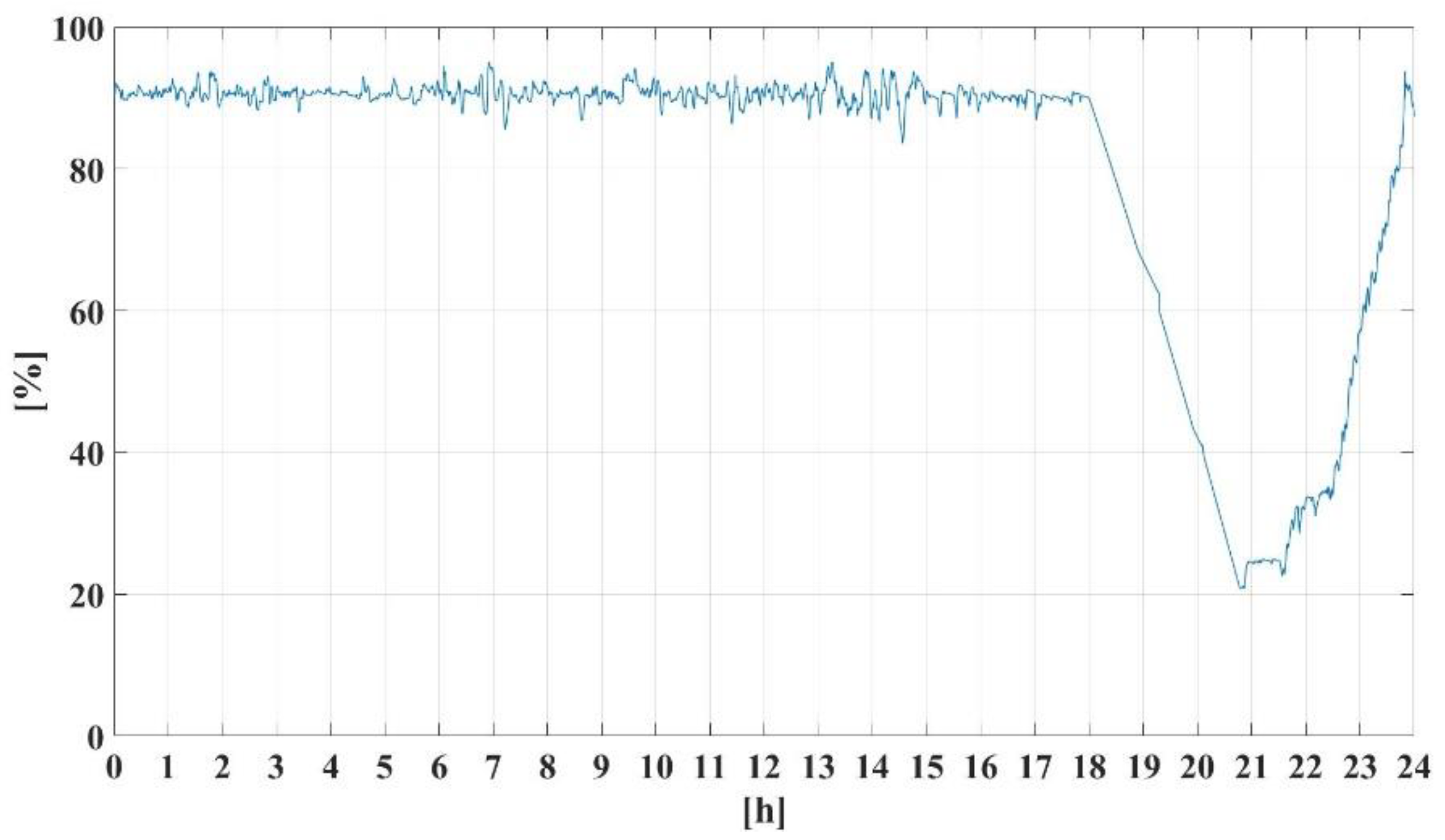
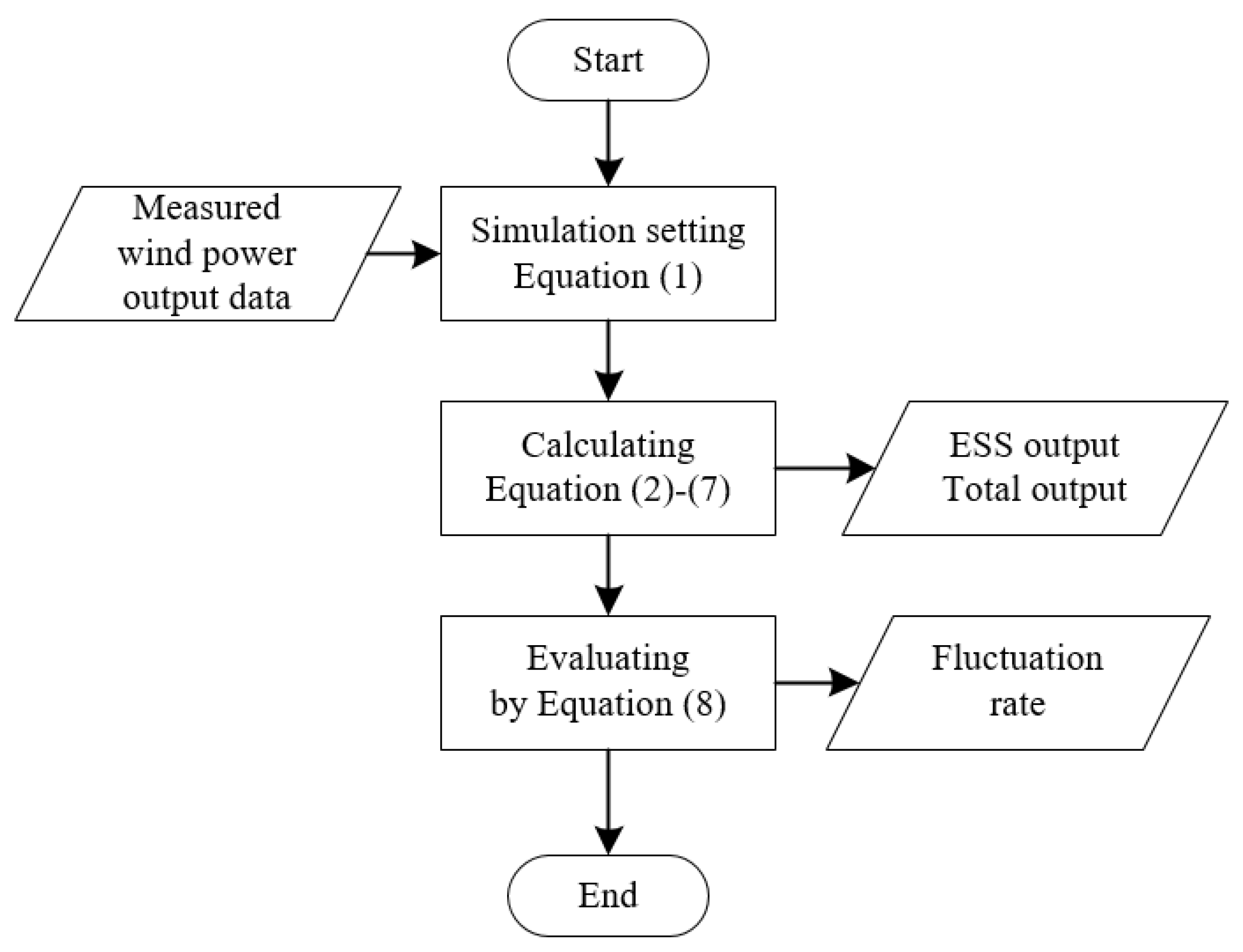
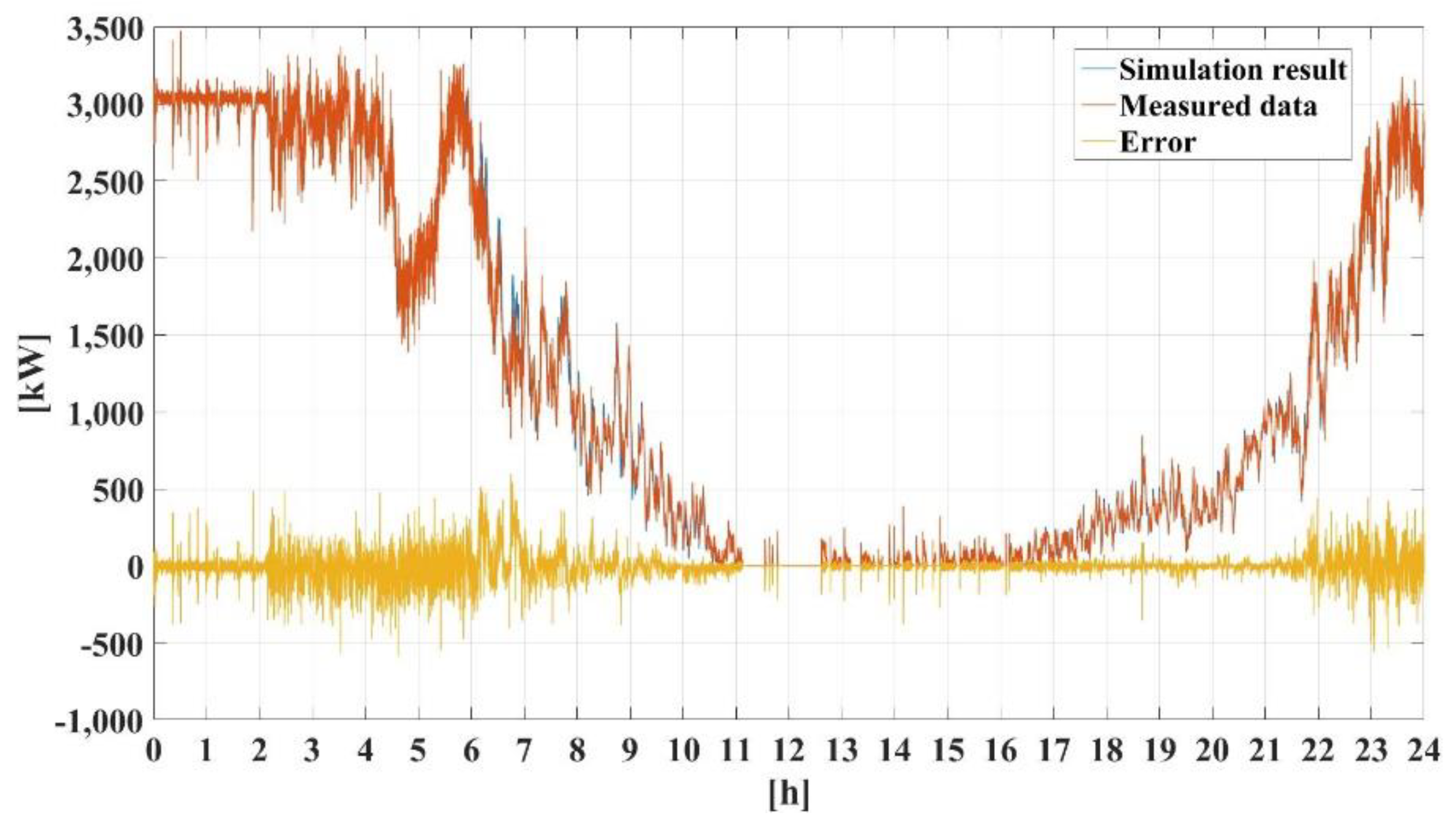
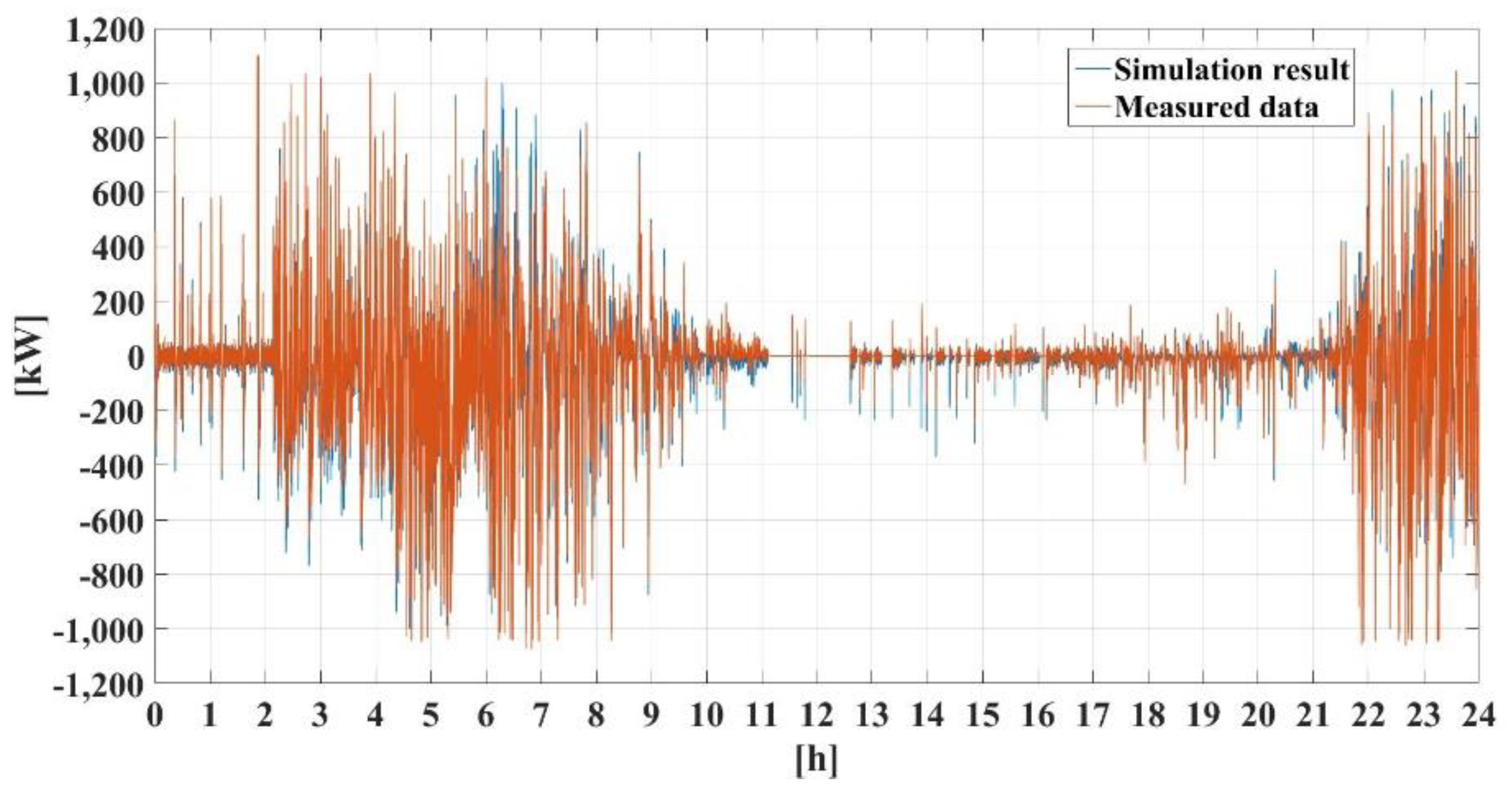
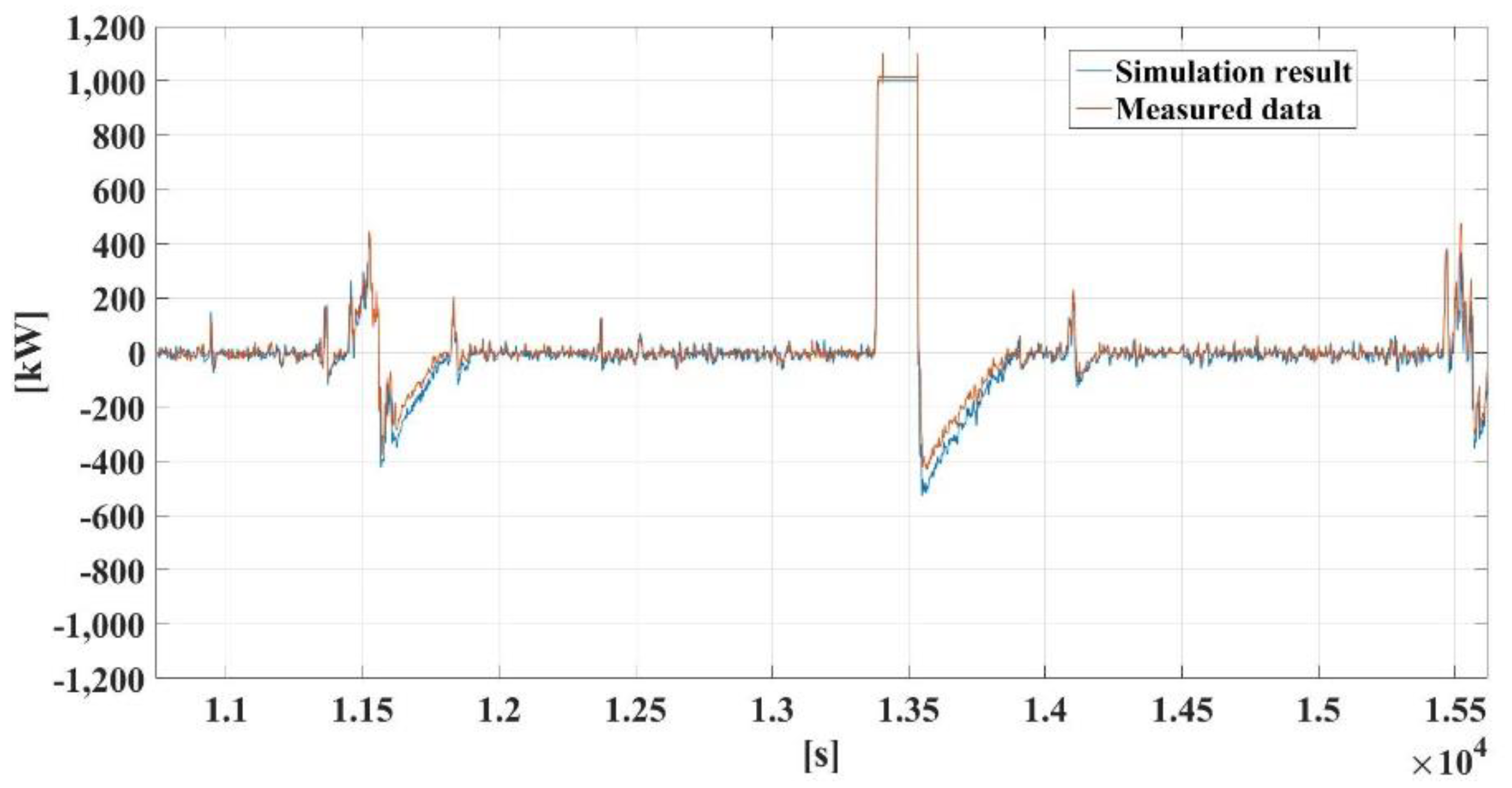
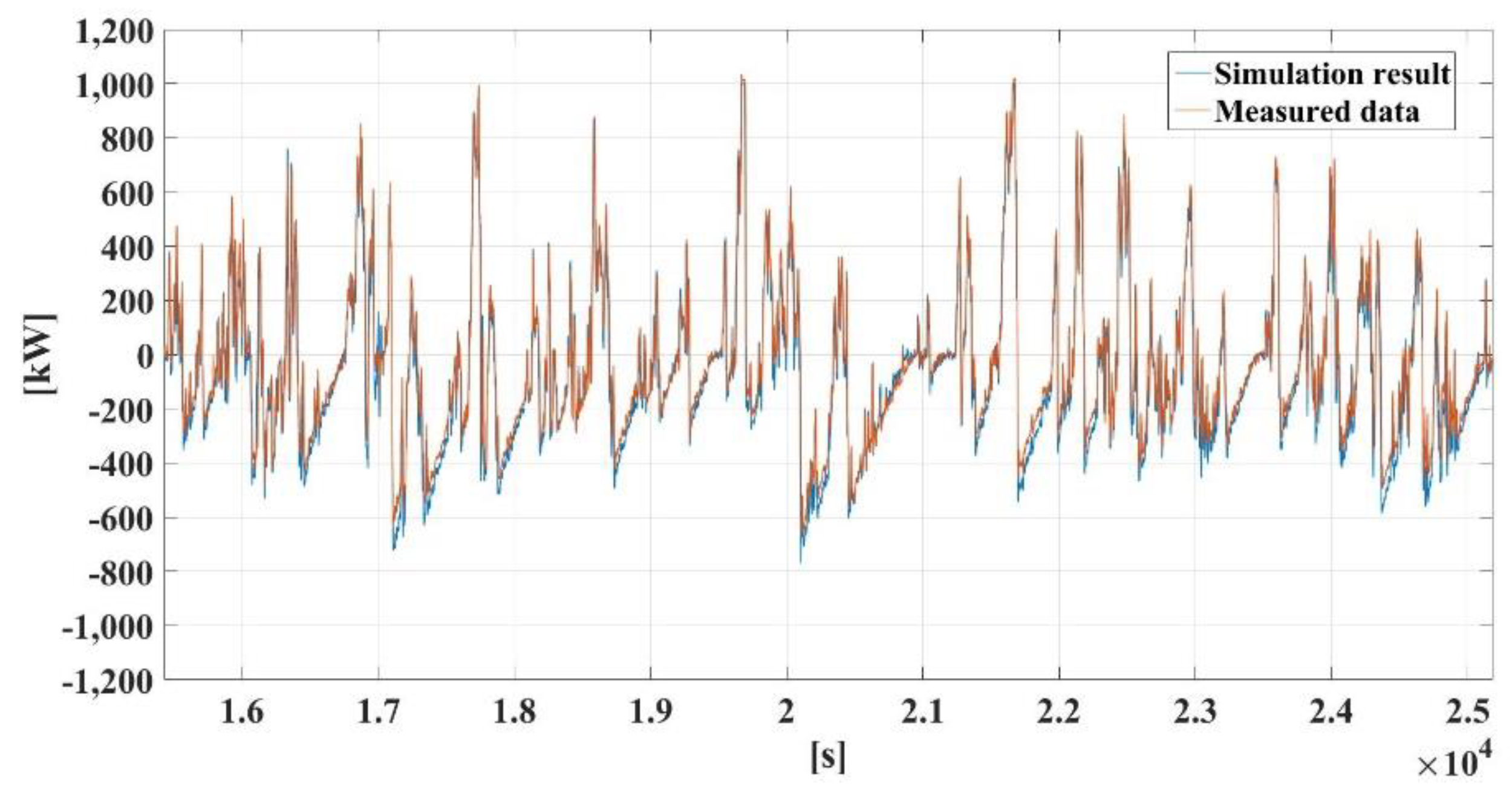
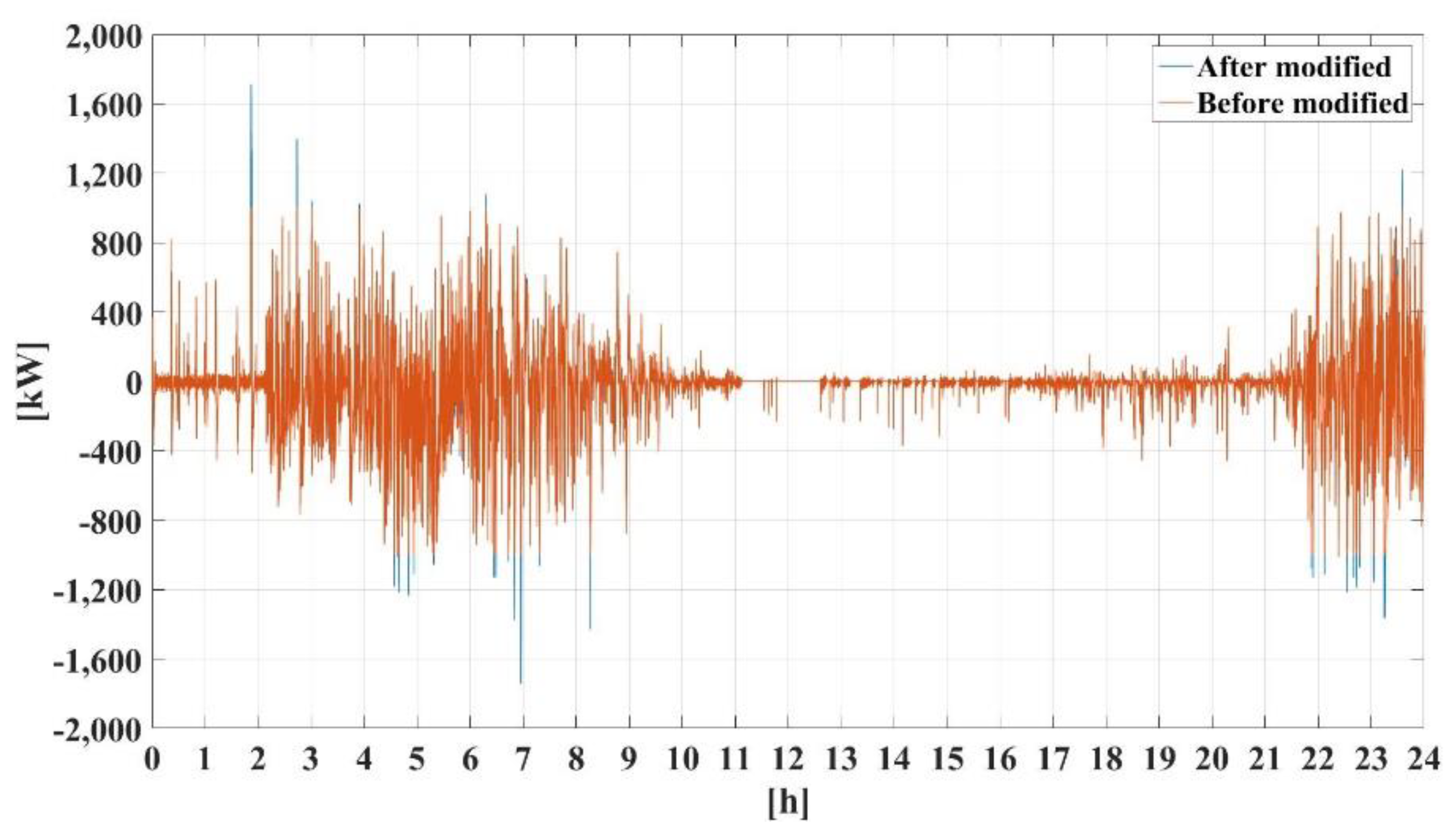
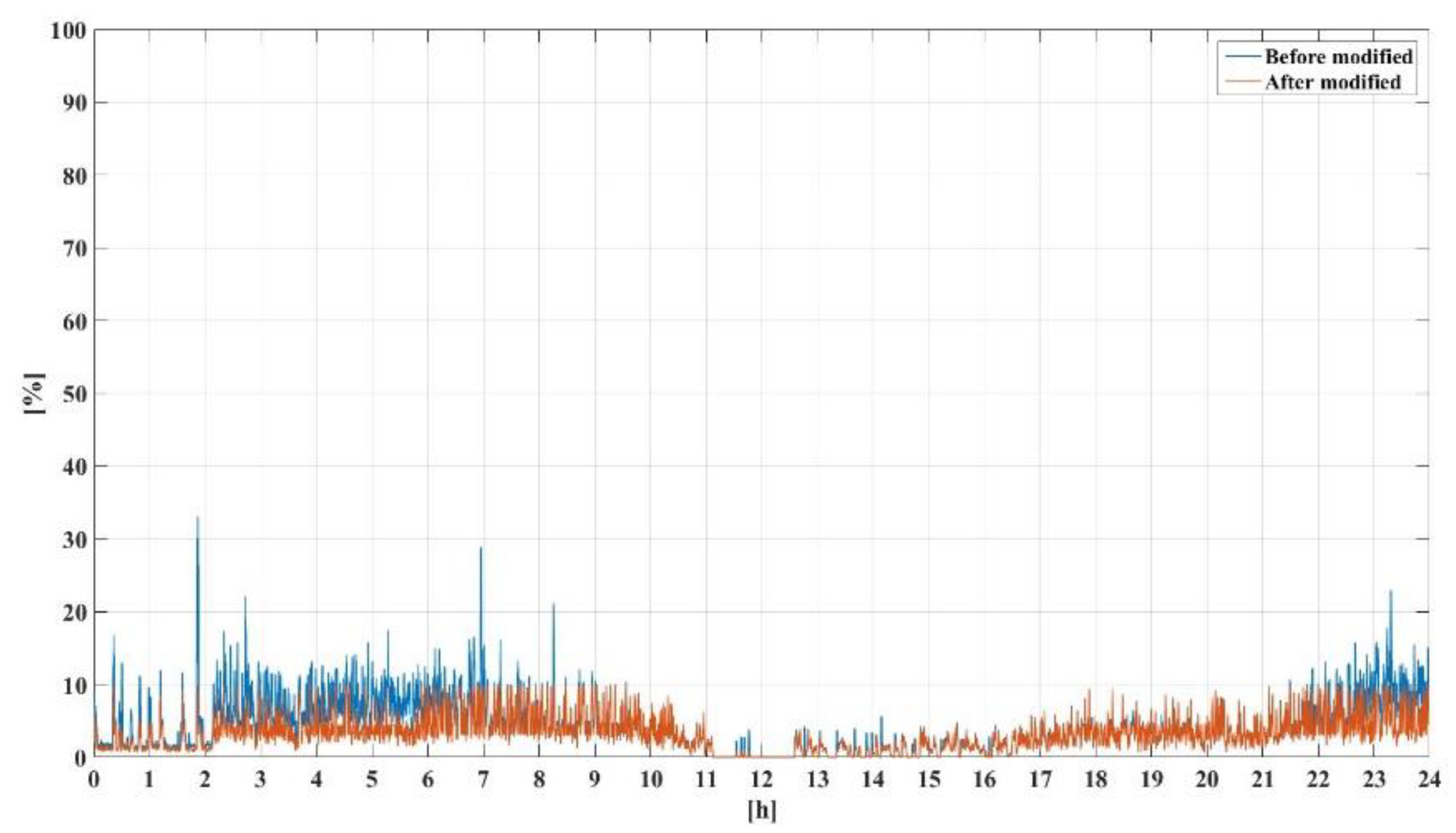
| Item | Value |
|---|---|
| 3000 kW | |
| 1000 kW | |
| 500 kWh | |
| 90% | |
| about 0.5 s | |
| 10% | |
| 0.5 | |
| 0.25 per unit | |
| 0.95 per unit |
Publisher’s Note: MDPI stays neutral with regard to jurisdictional claims in published maps and institutional affiliations. |
© 2020 by the authors. Licensee MDPI, Basel, Switzerland. This article is an open access article distributed under the terms and conditions of the Creative Commons Attribution (CC BY) license (http://creativecommons.org/licenses/by/4.0/).
Share and Cite
Chae, S.H.; Kang, C.U.; Kim, E.-H. Field Test of Wind Power Output Fluctuation Control Using an Energy Storage System on Jeju Island. Energies 2020, 13, 5760. https://doi.org/10.3390/en13215760
Chae SH, Kang CU, Kim E-H. Field Test of Wind Power Output Fluctuation Control Using an Energy Storage System on Jeju Island. Energies. 2020; 13(21):5760. https://doi.org/10.3390/en13215760
Chicago/Turabian StyleChae, Sang Heon, Chul Uoong Kang, and Eel-Hwan Kim. 2020. "Field Test of Wind Power Output Fluctuation Control Using an Energy Storage System on Jeju Island" Energies 13, no. 21: 5760. https://doi.org/10.3390/en13215760
APA StyleChae, S. H., Kang, C. U., & Kim, E.-H. (2020). Field Test of Wind Power Output Fluctuation Control Using an Energy Storage System on Jeju Island. Energies, 13(21), 5760. https://doi.org/10.3390/en13215760





